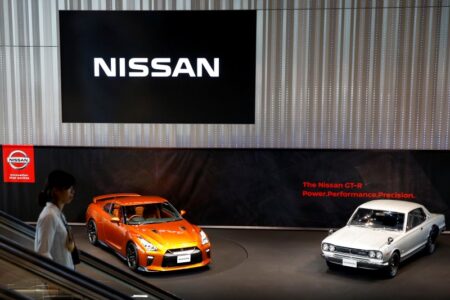Investing.com – The U.S. presidential election in November has major implications for Japanese automakers, as the candidates’ policies on climate change, trade and regulations will directly impact the industry.
Analysts at Citi Research explored how the outcome of the election — whether Donald Trump or Kamala Harris — could reshape the environment for these automakers, particularly when it comes to electric vehicle adoption, environmental regulations, and trade relations.
According to Citigroup, a Trump win would likely ease federal restrictions on greenhouse gas emissions and average fuel economy for businesses. Under his administration, California’s Advanced Clean Vehicles II regulations, which would impose stricter requirements on zero-emission vehicles, could be repealed.
This would ease the pressure on automakers to quickly switch to electric vehicles, as they would no longer face the imminent threat of penalties if they did not comply.
The financial risks of failing to meet these targets would be greatly reduced, providing immediate relief to companies struggling to accelerate production of zero-emission electric vehicles.
However, while Trump has expressed some support for electric vehicles, he has expressed a preference for market-driven outcomes rather than government-imposed targets.
His position on eliminating electric vehicle tax credits under the Inflation Reduction Act could slow the pace of electric vehicle adoption in the United States.
Without these incentives, the economic case for electric vehicles weakens, potentially hurting demand. For Japanese automakers, this is a mixed bag.
The pressure to innovate and launch new electric car models may ease, allowing them to focus on improving their existing gasoline and hybrid car lines.
At the same time, its long-term competitiveness in the electric vehicle market could suffer if global momentum shifts significantly toward electrification, as is expected in regions such as Europe and China.
Trade is another major area of concern. Trump’s protectionist approach is likely to return, with a focus on imposing tariffs on imports, especially those from Mexico.
For Japanese automakers like Mazda and Nissan, which have large production facilities in Mexico, this poses a significant risk. They could face higher costs if tariffs are imposed on vehicles made in Mexico, making their products less competitive in the U.S. market.
This would disproportionately affect companies that rely heavily on Mexico for production and have less domestic manufacturing in the United States. Conversely, Honda Aramex (NYSE:), with its high levels of local sourcing and U.S. production, will be better positioned to withstand such trade restrictions.
On the other hand, a Harris win would maintain the continuity of current climate policies, strengthening regulatory frameworks that push automakers toward a greener future.
Under Harris, federal greenhouse gas and average fuel economy regulations for companies will remain strict, and California’s ACCII rules, which set targets for low-emission electric vehicle sales starting in 2026, will be fully enforced.
This is likely to create a challenging environment for Japanese automakers, especially those that are lagging behind in developing electric vehicles. Companies such as Mazda, Subaru and Nissan — which currently have low EV sales — could face significant financial penalties if they fail to comply with the regulations.
Analysts said the penalties are significant, with potential fines of up to $20,000 per vehicle for non-compliance, a cost that could severely impact their bottom line.
For automakers with a more advanced EV strategy, such as Toyota (NYSE:) and Honda, the impact of Harris’s administration may be less severe.
These companies are better positioned to meet their EV sales targets, and have already made significant investments in hybrid and electric vehicles.
For example, Toyota has long advocated a multi-track approach that includes hybrids and plug-in hybrids, which could prove useful as the U.S. struggles to meet ambitious electric vehicle sales targets.
However, even under a Democratic administration, the gap between regulatory goals and actual electric vehicle sales is widening.
The battery electric vehicle (BEV) market in the United States is still growing, with BEVs currently accounting for only about 8% of the total market.
With regulatory requirements increasing, there is a real risk that automakers will not be able to scale up production of hybrid electric vehicles at the required pace, which could prompt the government to reconsider the severity of penalties.
However, Harris’s strong commitment to climate change initiatives and his support for California’s autonomy over its environmental policies suggest that easing these regulatory restrictions is unlikely.
Trade policy will also play a major role under a Harris administration, especially with regard to China.
The current Democratic administration has maintained a firm stance on reducing reliance on Chinese-made components, especially in the electric vehicle supply chain.
This could create further challenges for automakers that rely on Chinese imports for batteries and other electric vehicle parts.
While this does not directly impact Japanese automakers as severely as it does U.S. automakers, global supply chain constraints could pose operational challenges.
